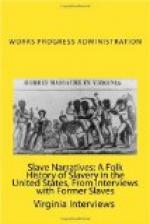“When I was a little girl my father was a Presbyterian so he sent me to boardin’ school in Cotton Plant and then sent me to Jacksonville, Illinois. I worked my board out up there. Mrs. Dr. Carroll got me a place to work. My sister learned to sew. She sewed for the public till her death. She sewed for both black and white folks. I stretches curtains now if I can get any to stretch and I irons. It give me rheumatism to wash. I used to wash and iron.
“My husband cooks on a Government derrick boat. He gets $1.25 and his board. They have the very best things to eat. He likes the work if he can stay well. He can cook pies and fancy cookin’. They like that. Say they can’t hardly get somebody work long because they want to be in town every night.
“We have one child. I used to be a primary teacher here at Clarendon.
“I never have voted. My husband votes but I don’t know what he thinks about it.
“I try to look at the present conditions in an encouraging way. The young people are so extravagant. The old folks in need. The thing most discouraging is the strangers come in and get jobs home folks could do and need and they can’t get jobs and got no money to leave on nor no place to go. People that able to work don’t work hard as they ought and people could and willin’ to work can’t get jobs. Some of the young folks do sure live wild lives. They think only of the present times. A few young folks are buying homes but not half of them got a home. They work where they let ’em have a room or a house. Different folks live all kinds of ways.”
Interviewer: Samuel S. Taylor
Person interviewed: Adelaide J. Vaughn
1122
Cross Street, Little Rock, Arkansas
Age: 69
“I was born in Huntsville, Alabama. My mother brought me from there when I was five years old. She said she would come to Arkansas because she had heard so much talk about it. But when she struck the Arkansas line, she didn’t like it and she wanted to go back. I have heard her say why but I don’t remember now; I done forgot. She thought she wouldn’t like it here, but she did after she stayed a while.
“My bronchial tubes git all stopped up and make it hard for me to talk. Phlegm gits all around. I been bothered with them a good while now.
“My mother, she was sold from her father when she was four years old. The rest of the children were grown then. Master Hickman was the one who bought her. I don’t know the one that sold her. Hickman had a lot of children her age and he raised her up with them. They were nice to her all the time.
“Once the pateroles came near capturing her. But she made it home and they didn’t catch her.
“Mr. Candle hired her from her master when she was about eighteen years old. He was nice to her but his wife was mean. Just because mother wouldn’t do everything the other servants said Mis’ Candle wanted to whip her. Mother said she knew that Mis’ Candle couldn’t whip her alone. But she was ’fraid that she would have Sallie, another old Negro woman slave, and Kitty, a young Negro woman slave, to help whip her.




